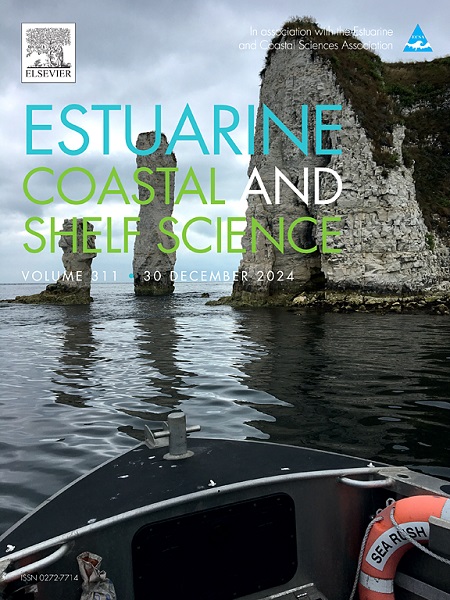高波区红树林潮汐生态系统滩涂恢复与保护的实验研究
IF 2.6
3区 地球科学
Q1 MARINE & FRESHWATER BIOLOGY
引用次数: 0
摘要
红树林具有几种基本功能,包括有机碳封存、波浪能量耗散、海滩稳定和海岸保护,以抵御海洋灾害。在高波浪活动的河口,为红树林滩涂的发展创造有利的环境,需要有针对性的消波和滩稳定措施。本研究以珠江口西岸黄茅海红树林潮滩的恢复为研究对象。为了消除波浪冲击,增强潮滩稳定性,对竹筏、人工鱼礁、松桩和生态牡蛎礁进行了不同组合的评价。利用模拟波浪动力学和泥沙输运的物理模型进行横断面试验,分析了不同波浪重复周期对红树林幼苗侵蚀和沉积的影响。结果表明:在5年的重复周期内,竹竿与人工鱼礁、松桩与生态牡蛎礁的组合具有显著的防侵蚀效果。恢复后的海滩表面在最初的1 ~ 2 m范围内观察到轻微侵蚀,最大侵蚀深度约为0.21 m。松桩与竹排组合的侵蚀范围更广,最大侵蚀深度为17.5 m,侵蚀深度为0.65 m。在30年和50年的复发间隔内,还分析了侵蚀模式。红树林恢复区内的海滩表面出现了明显的侵蚀,破坏了其保持原始状态的能力。一项对不同竹排配置对红树林种植区土壤侵蚀和沉积影响的比较分析表明,竹排本身和距竹排5米范围内种植的红树林都能起到保护作用。然而,这种保护作用随着距离的增加而减弱。研究结果为高浪区红树林滩涂的保护、恢复和可持续管理提供了科学依据。本文章由计算机程序翻译,如有差异,请以英文原文为准。
Experimental study on the restoration and protection of mangrove tidal ecosystems flat located in a high wave area
Mangrove forests perform several essential functions, including organic carbon sequestration, wave energy dissipation, beach stabilization, and coastal protection against marine hazards. Establishing a favorable environment for developing mangrove tidal flats in estuaries with high wave activity requires targeted wave dissipation and beach stabilization measures. This study focuses on the restoration of mangrove tidal flats in the Huangmaohai Sea (HMHS), located on the western coast of the Pearl River Estuary (PRE), China. To dissipation wave impacts and enhance tidal flat stability, various combinations of bamboo rafts, artificial reefs, pine piles, and ecological oyster reefs were evaluated. Using cross-sectional experiments utilizing a physical model simulating wave dynamics and sediment transport, this study analyzes erosion and deposition patterns affecting mangrove seedlings under different wave recurrence intervals. The results indicate that under a 5 yr recurrence interval, the combinations of bamboo poles with artificial reefs and pine piles with ecological oyster reefs exhibit significant anti-erosion effects. Minor erosion was observed within the initial 1–2 m of the restored beach surface, with a maximum erosion depth of approximately 0.21 m. In contrast, the combination of pine piles and bamboo rows experienced more extensive erosion, with a maximum reach of 17.5 m and an erosion depth of 0.65 m. Erosion patterns under 30 and 50 yr recurrence intervals were also analyzed. The beach surface within the mangrove restoration area exhibits significant erosion, impairing its ability to maintain its original condition. A comparative analysis of the impact of varying bamboo row configurations on soil erosion and deposition in mangrove planting areas reveals that protection is afforded by both the bamboo rows themselves and the planted mangroves within a distance of up to 5 m from the rows. However, this protective effect diminishes with increasing distance. These findings provide a scientific foundation for the protection, restoration, and sustainable management of mangrove tidal flats in high wave areas.
求助全文
通过发布文献求助,成功后即可免费获取论文全文。
去求助
来源期刊
CiteScore
5.60
自引率
7.10%
发文量
374
审稿时长
9 months
期刊介绍:
Estuarine, Coastal and Shelf Science is an international multidisciplinary journal devoted to the analysis of saline water phenomena ranging from the outer edge of the continental shelf to the upper limits of the tidal zone. The journal provides a unique forum, unifying the multidisciplinary approaches to the study of the oceanography of estuaries, coastal zones, and continental shelf seas. It features original research papers, review papers and short communications treating such disciplines as zoology, botany, geology, sedimentology, physical oceanography.

 求助内容:
求助内容: 应助结果提醒方式:
应助结果提醒方式:


